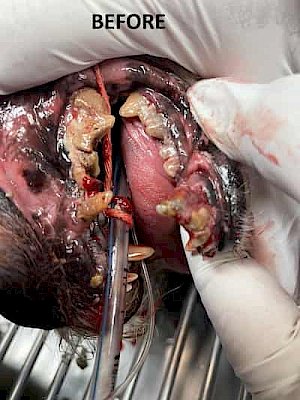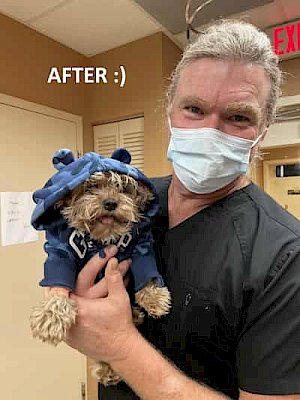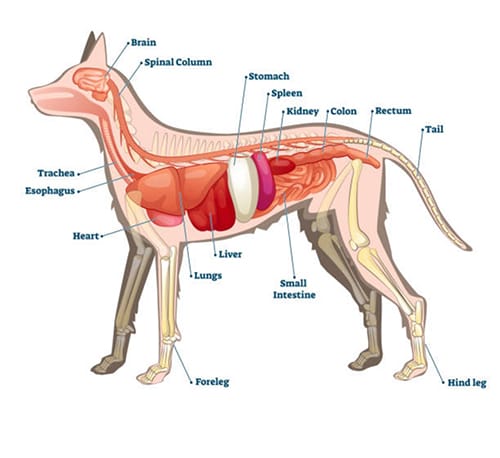Dental Awareness Month in August!!
Periodontal Disease is defined as a set of inflammatory conditions affecting the tissues surrounding the teeth.
This disease process affects more than 80% of our pet cats and dogs. In its earliest stage this is called gingivitis in which the gums become red and swollen and will frequently bleed. In its more serious form the gums can pull away from the tooth, bone can be lost, and the teeth may loosen or fall out. Significant bad breath is also associated to say the least.
How does Periodontal Disease Form?
The mouth is home to millions of bacteria. As the bacteria multiplies on the gums and teeth, it forms an invisible layer called plaque and organizes into a biofilm, which is a collection of bacteria that is structured in a way that becomes very resistant to removal and difficult for antibiotics to access. If left, it begins to mineralize that results in tarter.


Symptoms of Periodontal Disease
- Foul breath (Halitosis)
- Extreme redness and bleeding gums
- Difficulty eating (painful mouth)
- Loose teeth
- Head shyness
- Nasal discharge
- Excessive drooling
- Systemic Infections
Can Periodontal Disease cause Systemic Disease?
 When your pet develops Periodontal Disease, significant quantities of bacteria reside within the mouth and oral tissue. Due to the diseased gums (gingivitis), bone loss, and infection of surrounding soft tissue the body's natural defense mechanism is destroyed. The bacteria present in the diseased mouth can now enter the bloodstream and travel to other areas within the body, causing distant or systemic effects. Although bacteria from the oral cavity can spread to everywhere in the body, there are three organs that are especially susceptible to the spread from the oral bacteria. The three organs most affected are the Heart, Liver, and the Kidneys all of which are vital.
When your pet develops Periodontal Disease, significant quantities of bacteria reside within the mouth and oral tissue. Due to the diseased gums (gingivitis), bone loss, and infection of surrounding soft tissue the body's natural defense mechanism is destroyed. The bacteria present in the diseased mouth can now enter the bloodstream and travel to other areas within the body, causing distant or systemic effects. Although bacteria from the oral cavity can spread to everywhere in the body, there are three organs that are especially susceptible to the spread from the oral bacteria. The three organs most affected are the Heart, Liver, and the Kidneys all of which are vital.
How to prevent Periodontal Disease
- Routine check ups with your veterinarian
- Yearly to bi-annual routine dental cleaning with your veterinarian
- Brush pets teeth with soft bristled toothbrush and use pet enzymatic toothpaste (minimally 2 times a week)
- Dental chew toys (use appropriately to avoid swallowing or erosion to teeth and gums)
What is involved in a Dental procedure?
Prior to the procedure, an evaluation of your pet will be required by your veterinarian, to establish the level of health of your pet as well as
your pet's oral health. Blood work to evaluate for systemic disease will be performed at that time as well. A discussion will be had for a more clear understanding on what will be expected, although plans could change.
During the procedure sometimes we have unexpected surprises regarding your pets teeth. Sometimes the teeth look very healthy from
the outside, but with X-rays that are performed on all our patients, occasionally we find periodontal disease that is not visible without it.
At that time, a phone call will be made to discuss plans while performing the dental work.
Our veterinarians Dr. Llanes and Dr. Schnirman and staff are highly experienced with all degrees of dental care, from the perfect mouth just needing routine cleaning all the way to the most severe periodontal disease. So give us a call for an evaluation of your pet's mouth.
Due to the frequency of periodontal disease as well as those clients that want to prevent periodontal disease, as usual, back by popular
demand, we are once again offering a 20% off the price of our Dental procedures during the Month of August. Give us a Call and Lets Get
Brushing!

